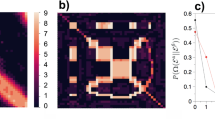Abstract
Network theories of memory were formulated as early as the second decade of the nineteenth century by now-obscure German and perhaps French metaphysicians. Without access to primary sources, the provocative ideas of a French author, M. de Cardaillac, are quoted by way of William Hamilton’s Lectures on Metaphysics at the University of Edinburgh in 1836 and 1837.
Similar content being viewed by others
References
BEVER, T. G., FODOR, J. A., & GARRETT, M. (1968). A formal limitation of associationism. In T. R. Dixon & D. L. Horton (Eds.), Verbal behavior and general behavior theory. Englwood Cliffs, NJ: Prentice-Hall.
BORING, E. G. (1929). A history of experimental psychology. New York: Century.
EBBINGHAUS, H. (1885, 1964). Memory a contribution to experimental psychology. New York: Dover.
ELLENBERGER, H. F. (1970). The discovery of the unconscious. New York: Basic Books.
FIELDS, L., ADAMS, B. J., VERHAVE, T., & NEWMAN, S. (1990). The effects of nodality on the formation of equivalence classes. Journal of the Experimental Analysis of Behavior, 53, 345–358.
HAMILTON, W. (1859). Lectures on metaphysics. Boston: Gould and Lincoln.
VAN HOORN, W., & VERHAVE, T. (1980). Wundt’s changing conception of a General and Theoretical Psychology. In W. G. Bringmann & R. O. Tweney (Eds.), Wundt Studies. A Centennial Collection (pp. 71–113). Gottingen, Germany & Toronto, Canada: C. J. Hochgrefe.
LASHLEY, K. (1951). The problem of serial order in behavior. In L. Jeffress (Ed.), Cerebral mechanism in behavior. New York: Wiley.
LEAHEY, T. H. (1992). The mythical revolutions of American psychology. American Psychologist, 47, 308–318.
OSGOOD, C. (1953). Method and theory in experimental psychology. New York: Oxford University Press.
SKINNER, B. F. (1957). Verbal behavior. New York: Appleton Century Crofts.
VERHAVE, T., & van HOORN, W. (1987). The winds of doctrine: Ebbinghaus and his reputation in America. In D. S. Gorfein & R. R. Hoffman (Eds.), Memory and learning. The Ebbinghaus Centennial Conference. Hillsdale, NJ: Erlbaum
WOODWORTH, R. S. (1938). Experimental psychology. New York: Holt.
Author information
Authors and Affiliations
Additional information
This paper was prepared with the support of Contract MDA903-90-C-0132 from the Army Research Institute to Lanny Fields.
Rights and permissions
About this article
Cite this article
Verhave, T. Network Theories of Memory: Before Wundt and Herbart. Psychol Rec 43, 547–552 (1993). https://doi.org/10.1007/BF03395898
Published:
Issue Date:
DOI: https://doi.org/10.1007/BF03395898



